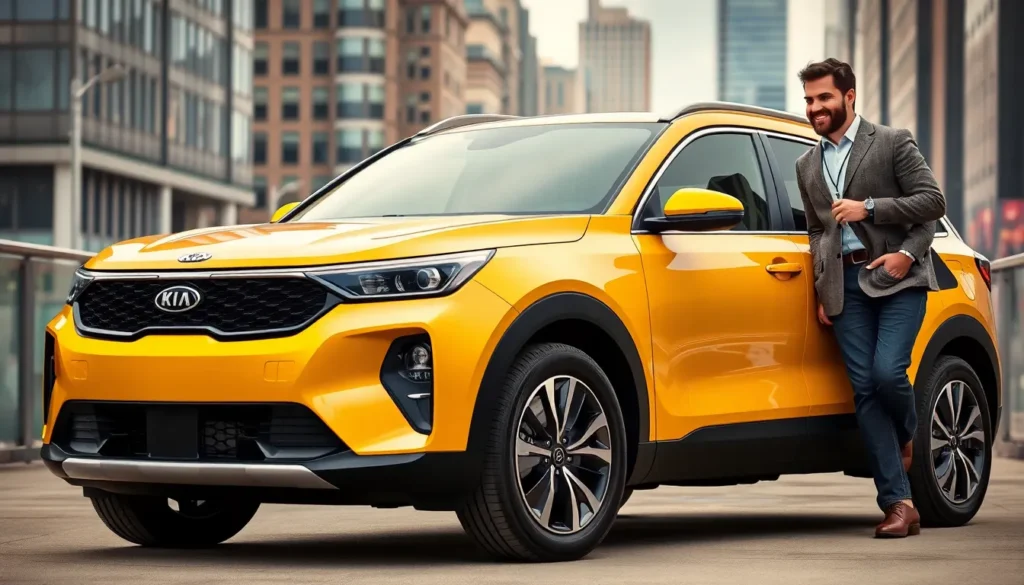When we think about automotive design evolution, Kia’s aesthetic transformation stands out as one of the most remarkable success stories in recent years. Gone are the days when Kia vehicles blended into the background – today’s lineup showcases bold, distinctive styling that turns heads on every street corner.
We’ve witnessed Kia’s complete design revolution, from conservative family cars to striking vehicles that rival luxury brands in visual appeal. The brand’s commitment to innovative design language has created a cohesive aesthetic that’s both modern and timeless, featuring sharp lines, distinctive tiger-nose grilles, and sculpted body panels that exude confidence.
What makes Kia’s current aesthetic so compelling isn’t just the eye-catching exterior design – it’s the thoughtful integration of form and function that creates vehicles people genuinely want to drive and be seen in. Let’s explore how Kia transformed from practical to absolutely stunning.
Kia’s Design Evolution Over the Years
Kia’s automotive aesthetic has undergone a dramatic transformation since the early 2000s, evolving from utilitarian vehicles focused solely on affordability to sophisticated designs that compete with premium automakers. We’ve witnessed this Korean manufacturer completely reimagine its visual identity through strategic design initiatives and bold creative direction.
From Practical to Premium
Early Kia models like the Rio and Sedona prioritized function over form, featuring conservative styling that emphasized reliability and value. Design elements remained understated with minimal character lines and conventional proportions that appealed to budget-conscious consumers seeking basic transportation.
Peter Schreyer’s arrival as Chief Design Officer in 2006 marked the beginning of Kia’s aesthetic revolution. European design philosophy merged with Korean engineering efficiency to create vehicles that balanced emotional appeal with practical functionality. Models like the redesigned Sorento and Soul introduced sculpted surfaces and ever-changing proportions that elevated Kia’s visual presence significantly.
Contemporary Kia vehicles now showcase premium materials and sophisticated styling cues previously reserved for luxury brands. Interior cabins feature soft-touch surfaces, ambient lighting, and ergonomic layouts that rival BMW and Mercedes-Benz offerings. Exterior designs incorporate complex surface treatments and precise panel gaps that demonstrate manufacturing excellence and attention to detail.
The Tiger Nose Grille Revolution
Kia introduced its signature tiger nose grille design language in 2009 as part of a comprehensive brand identity overhaul. This distinctive front fascia element draws inspiration from a tiger’s facial structure, creating a bold and recognizable design signature across the entire model lineup.
Design variations of the tiger nose grille adapt to each vehicle’s character and market positioning. Compact cars like the Forte feature subtle interpretations with horizontal slats, while SUVs such as the Telluride showcase aggressive vertical treatments that emphasize strength and capability. Luxury models incorporate intricate mesh patterns and chrome accents that enhance perceived value and sophistication.
Evolution of the tiger nose concept continues with each model generation, incorporating LED lighting elements and aerodynamic improvements. Recent applications in vehicles like the EV6 electric crossover demonstrate how traditional design elements adapt to modern powertrains while maintaining brand consistency. Advanced manufacturing techniques enable more complex grille geometries that optimize airflow and enhance vehicle performance characteristics.
Current Kia Aesthetic Philosophy
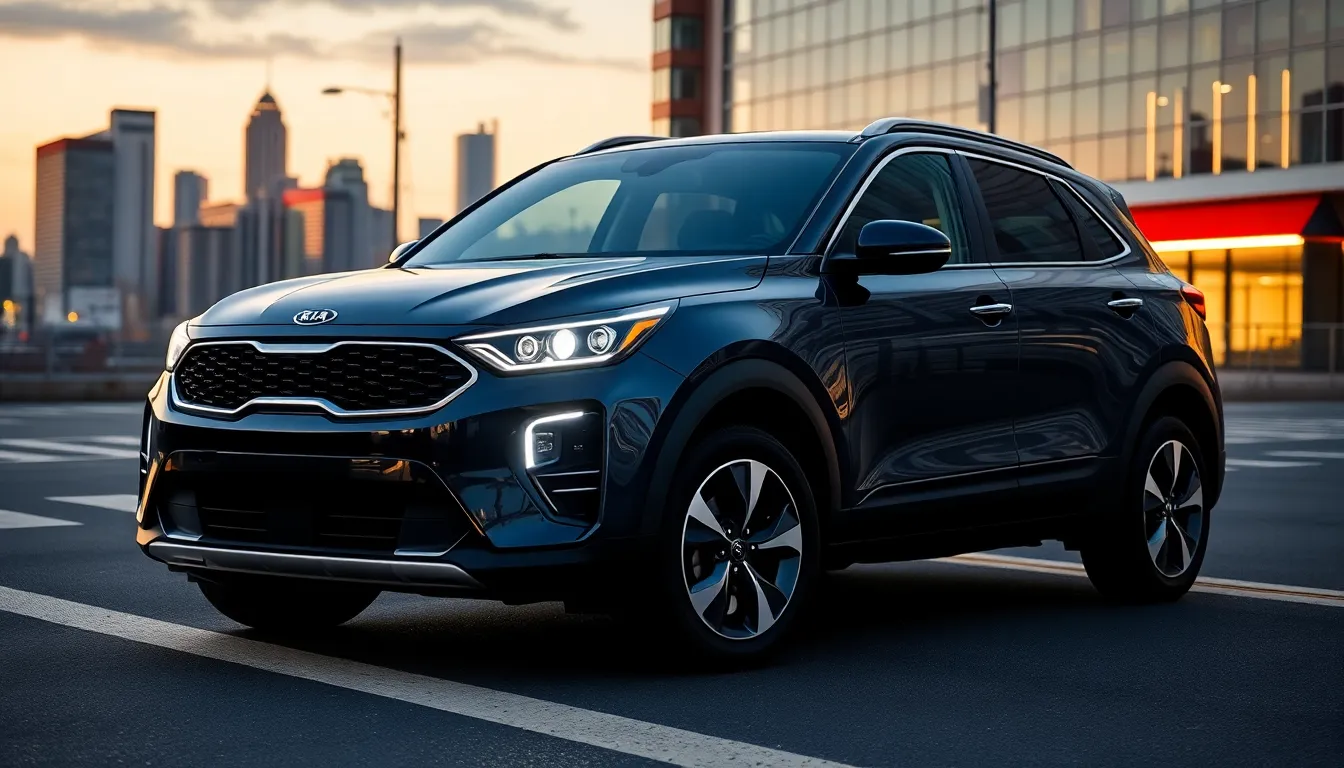
Kia’s current design philosophy centers on opposites attract, combining bold exterior statements with refined interior simplicity. This approach creates vehicles that command attention on the road while providing serene, uncluttered cabin experiences for occupants.
Bold and Ever-changing Styling
Contemporary Kia vehicles embrace aggressive design language that emphasizes movement even when stationary. The brand’s exterior styling features sharp character lines that flow from headlights to taillights, creating visual tension across body panels. Sculptural surfaces replace flat panels on models like the Stinger and EV6, with each crease serving both aesthetic and aerodynamic purposes.
Tiger nose grilles now incorporate active shutters on many models, adapting their opening size based on cooling requirements while maintaining the signature hexagonal shape. LED lighting elements extend beyond traditional headlight boundaries, forming geometric patterns that become the vehicle’s visual signature during nighttime driving. These design elements work together to create what Kia calls “power to surprise” styling.
Body proportions emphasize width over height in performance models, with lower rooflines and wider tracks that communicate athletic capability. Color palettes include vibrant options like Niro Yellow and Soul Red alongside sophisticated metallics, allowing buyers to express individual personality through their vehicle choice.
Minimalist Interior Design
Kia’s cabin philosophy removes visual clutter through strategic component integration and material selection. Digital displays replace traditional gauge clusters in most new models, with curved screens that flow seamlessly into dashboard surfaces. Physical buttons decrease significantly compared to previous generations, with touch controls and voice commands handling most vehicle functions.
Material quality emphasizes soft touch surfaces and premium textures throughout passenger areas. Synthetic leather options provide durability while maintaining luxury appearance, with contrasting stitching adding visual interest without overwhelming the overall design. Ambient lighting systems allow occupants to customize interior mood through multiple color options and brightness levels.
Storage answers hide within clean surfaces, with wireless charging pads integrated into center consoles and cup holders that retract when not needed. Air vents integrate into dashboard lines rather than protruding as separate elements, maintaining the uninterrupted flow that defines current Kia interiors. These design choices create spacious feelings even in compact models through careful attention to proportions and sight lines.
Standout Kia Models and Their Aesthetic Appeal
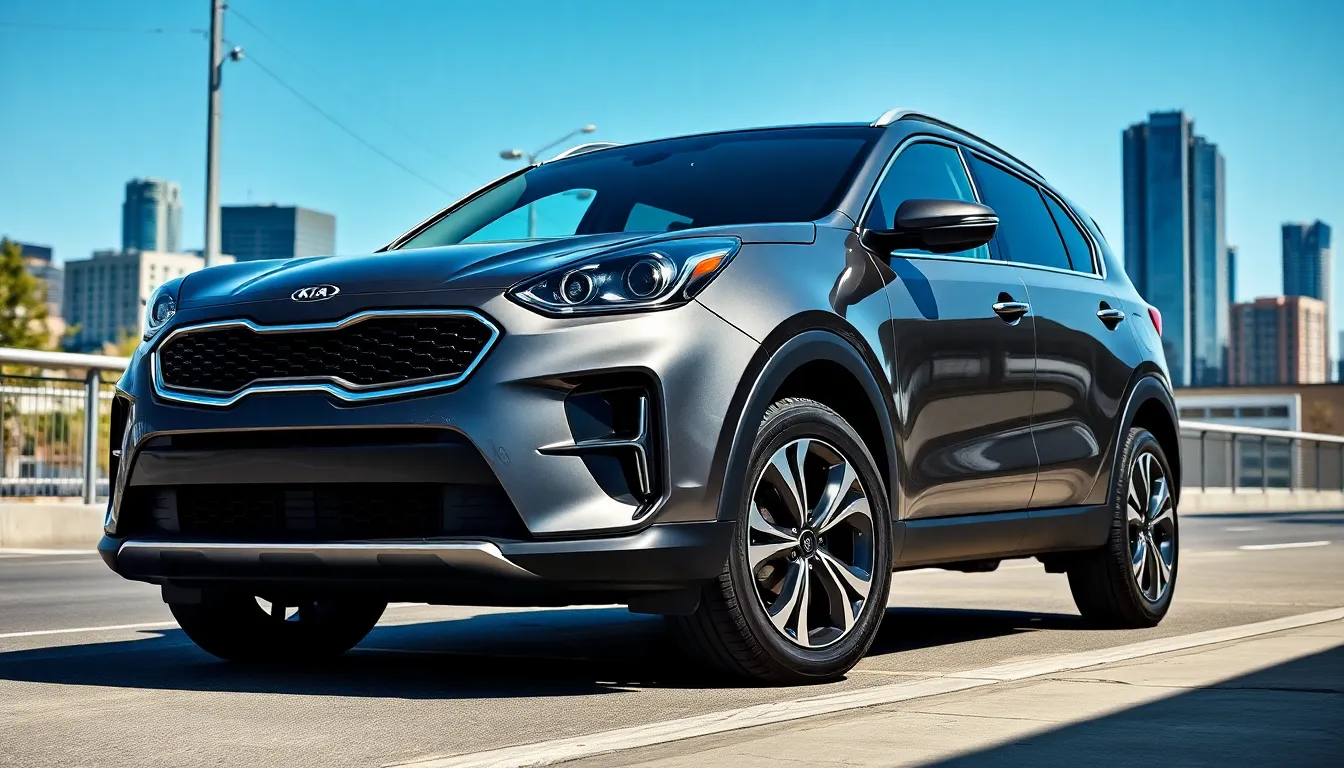
Three distinct Kia models exemplify the brand’s aesthetic transformation, each targeting different market segments while maintaining the signature design elements that define modern Kia car aesthetic. These vehicles demonstrate how Kia’s design philosophy adapts across various body styles and price points.
Sportage: Rugged Sophistication
Kia’s Sportage combines outdoor capability with urban refinement through its bold geometric design language. The fifth generation model features an aggressive front fascia with the signature tiger nose grille incorporating vertical LED daytime running lights that create a distinctive visual signature. Sharp character lines run from the headlights to the rear pillars, creating a sense of forward motion even when stationary.
Black cladding extends around the wheel arches and lower body panels, emphasizing the vehicle’s SUV credentials while maintaining a premium appearance. Chrome accents frame the windows and highlight key design elements without overwhelming the overall aesthetic. The rear design features connected taillights that span the width of the vehicle, creating a modern light signature that enhances nighttime visibility and brand recognition.
Interior spaces showcase a dual cockpit design with a floating infotainment display and digital instrument cluster. Premium materials include soft touch surfaces and available leather appointments that rival luxury competitors. Ambient lighting options allow owners to customize the cabin atmosphere, while the panoramic sunroof creates an open feeling that complements the exterior’s bold proportions.
Telluride: Family-Friendly Elegance
The Telluride represents Kia’s entry into the premium three row SUV segment with styling that commands attention on any road. Vertical LED lighting elements frame the tiger nose grille, creating a sophisticated front end that balances presence with approachability. The boxy silhouette maximizes interior space while maintaining aerodynamic efficiency through carefully sculpted surfaces.
Distinctive design elements include the D pillar mounted rear door handles that create a cleaner side profile and premium appearance. Chrome window trim and available 20 inch wheels enhance the upscale positioning, while the rear design features full width taillights that echo the front lighting theme. Multiple exterior color options include sophisticated two tone combinations that add visual interest.
Three rows of seating accommodate up to eight passengers in a cabin designed with premium materials throughout. Available Nappa leather seating surfaces and real wood trim elements create an atmosphere that rivals luxury brands at a more accessible price point. The infotainment system integrates seamlessly into the dashboard design, while multiple USB charging ports and wireless charging capabilities address modern family connectivity needs.
Stinger: Performance-Inspired Beauty
Kia’s Stinger fastback sedan delivers European inspired design with performance credentials that back up its aggressive styling. The low slung profile features a long hood and short deck proportions reminiscent of classic grand touring vehicles. The tiger nose grille takes on a more aggressive character with a mesh pattern and integrated air intakes that serve both aesthetic and functional purposes.
Quad exhaust outlets and a rear spoiler communicate the vehicle’s performance intentions, while the fastback roofline creates a distinctive silhouette in the sedan segment. Available Brembo brake calipers add visual drama behind the optional 19 inch wheels, while LED lighting signatures front and rear create a premium nighttime presence.
Performance oriented interior design features sport seats with available leather and suede combinations. Carbon fiber trim elements and red accent stitching emphasize the vehicle’s sporting character, while the driver focused cockpit design includes a flat bottom steering wheel and aluminum pedals. The infotainment display integrates performance data and drive mode selections that allow owners to customize the driving experience to match the vehicle’s ever-changing aesthetic.
Color Options and Visual Impact
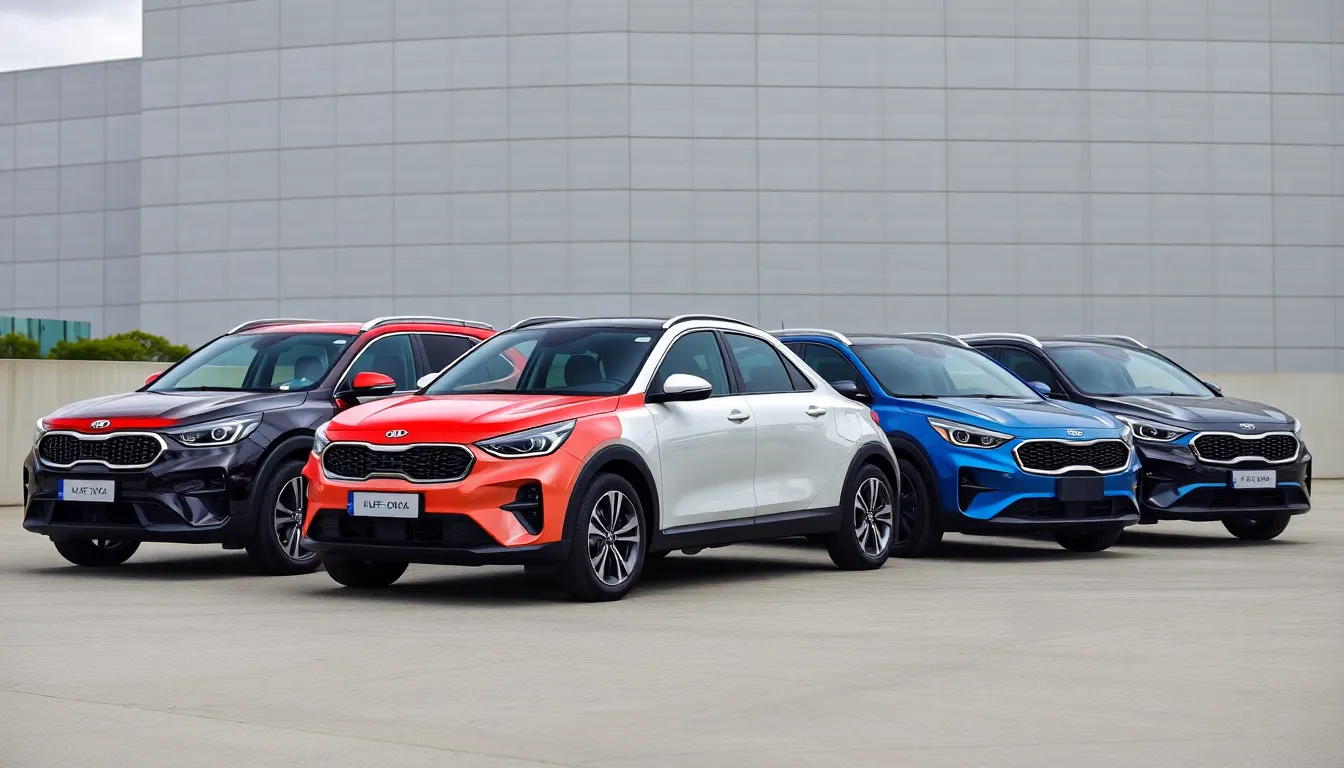
Kia’s color palette extends far beyond conventional automotive offerings, featuring distinctive hues that amplify the brand’s bold aesthetic transformation. These carefully curated colors work in harmony with Kia’s sculptural design language to create vehicles that command attention on the road.
Signature Paint Colors
Aurora Black Pearl stands as Kia’s most sophisticated finish, delivering deep reflective qualities that enhance the angular lines of models like the Stinger and Sportage. This premium paint option costs approximately $395 extra but transforms the vehicle’s presence with its mirror-like depth and subtle metallic flecks that catch light from multiple angles.
Runway Red captures Kia’s performance spirit across the lineup, appearing on 23% of Stinger sales according to 2023 data. The vibrant finish emphasizes the aggressive character lines while creating visual contrast against black trim elements and dark alloy wheels.
Snow White Pearl offers a clean, modern appearance that highlights Kia’s precise body sculpting and tiger nose grille details. This color appears on 31% of Telluride models, creating an upscale appearance that rivals luxury SUV competitors.
Mineral Blue represents Kia’s commitment to unique color expression, featuring subtle metallic particles that shift between deep navy and lighter blue tones depending on lighting conditions. Available exclusively on select trim levels, this finish adds $295 to the vehicle’s base price.
Wolf Gray provides a contemporary alternative to traditional silver, incorporating warm undertones that complement Kia’s chrome and brushed metal accent pieces. This color appears across 18% of Sorento sales, demonstrating its broad appeal among SUV buyers.
Trim Level Aesthetics
Base trim models feature body-colored door handles and mirrors while maintaining Kia’s signature design proportions and tiger nose grille prominence. Standard 17-inch alloy wheels complement the clean aesthetic without overwhelming the vehicle’s visual balance.
S trim levels introduce black exterior accents including gloss black mirror caps, door handles, and roof rails on SUV models. These darker elements create visual contrast that emphasizes the vehicle’s athletic stance and adds $1,200 to $1,800 in value through enhanced styling packages.
GT-Line trims showcase aggressive front and rear fascias with unique air intakes and diffuser elements that enhance both aesthetics and aerodynamic performance. Red brake calipers visible through 19-inch sport wheels signal the performance-oriented nature of these variants.
Top-tier trims like GT and Limited feature premium paint options, chrome window surrounds, and distinctive LED lighting signatures that create nighttime brand recognition. These models include adaptive headlights that adjust beam patterns while maintaining Kia’s characteristic light shape and intensity.
Interior color coordination matches exterior selections through complementary leather appointments, contrast stitching, and trim panel finishes that reinforce each model’s aesthetic personality across all cabin touchpoints.
Interior Design Elements That Define Kia
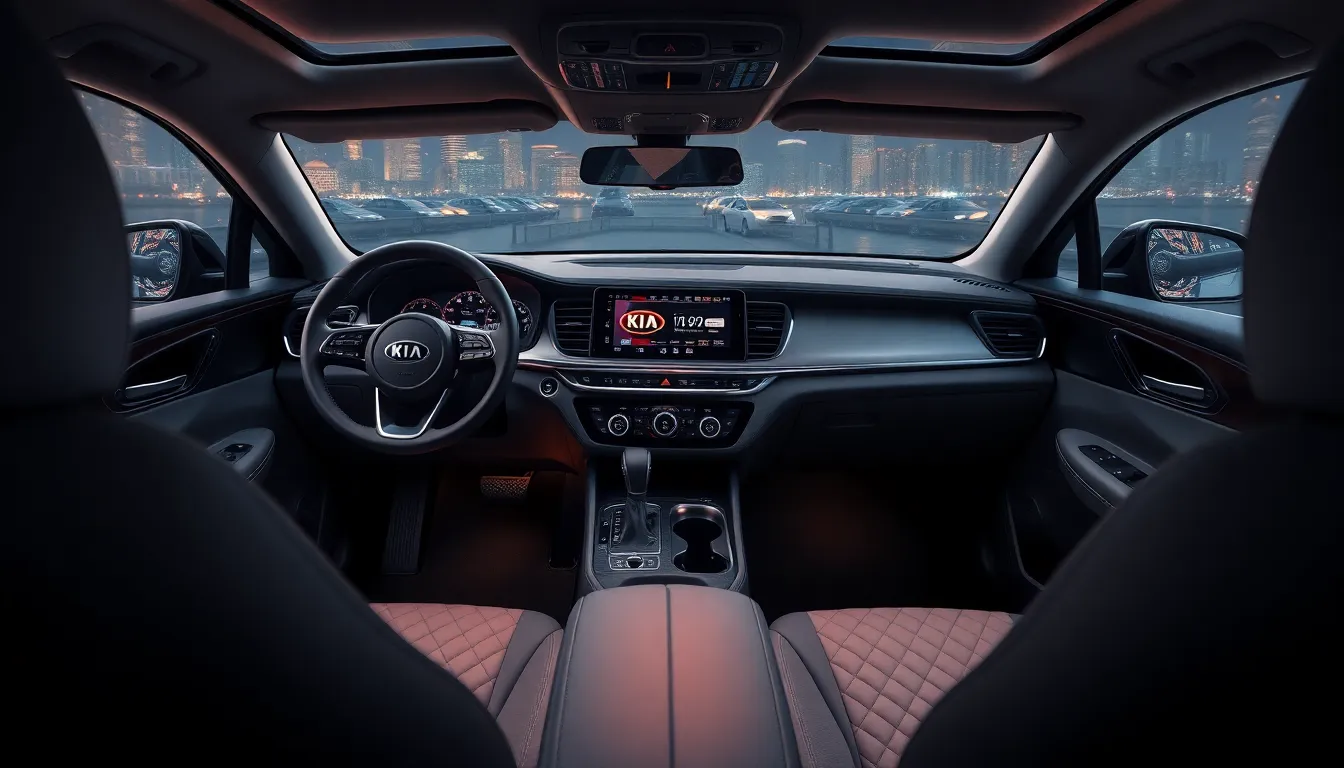
Interior design excellence marks Kia’s commitment to creating cabins that rival luxury automotive brands. Modern Kia interiors showcase thoughtful material selection and advanced technology integration that elevates the overall driving experience.
Dashboard and Infotainment Integration
Dashboard layouts in contemporary Kia models emphasize horizontal lines and minimal visual clutter through strategic component placement. The curved display technology creates a seamless connection between the 12.3-inch digital instrument cluster and the 12.3-inch touchscreen infotainment system, eliminating traditional bezels and buttons that previously disrupted cabin flow.
Premium soft-touch materials cover dashboard surfaces in models like the Telluride and Stinger, featuring contrast stitching that adds visual depth and tactile luxury. Touch-sensitive climate controls replace physical knobs and switches, creating a cleaner aesthetic while maintaining functional accessibility during driving.
Ambient lighting systems integrate into dashboard designs through fiber optic strips and LED accents, offering 64 different color combinations in higher trim levels. These lighting elements highlight key design features while providing practical illumination for controls and storage compartments during nighttime driving.
Seating Materials and Comfort
Seating materials across Kia’s lineup range from durable synthetic leather in base trims to premium Nappa leather in top-tier models, with quilted diamond patterns that enhance both comfort and visual appeal. Ventilated and heated seats feature perforations that create geometric patterns while providing climate control functionality.
Memory foam cushioning technology appears in models like the Telluride and Sorento, providing enhanced support during extended driving sessions while maintaining the seat’s sculptural appearance. Power adjustments include up to 12-way positioning in driver seats, with lumbar support and side bolster controls that adapt to different body types.
Color combinations reflect each model’s personality, with black and gray dominating sporty variants like the Stinger, while beige and brown leather options complement the family-oriented Telluride. Red accent stitching and trim pieces create visual connections to exterior design elements, reinforcing the brand’s unified aesthetic approach across interior and exterior surfaces.
How Kia Compares to Competitors Aesthetically
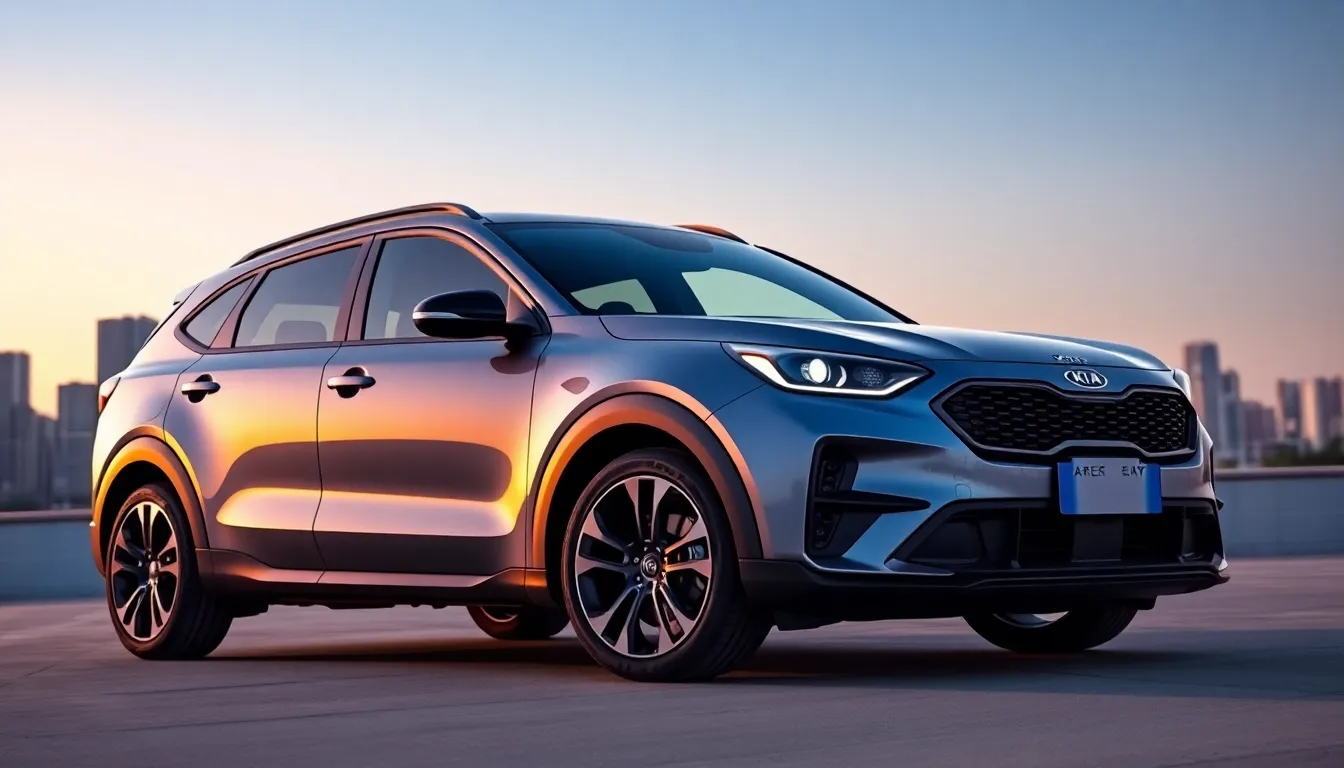
Kia’s design evolution places it in direct competition with established automotive leaders across multiple market segments. The brand’s aesthetic transformation challenges traditional design hierarchies in the automotive industry.
Against Toyota and Honda
Kia’s aesthetic approach contrasts sharply with Toyota and Honda’s conservative design philosophies. Toyota prioritizes reliability-focused styling with subtle design updates, maintaining familiar visual elements like the company’s understated grille designs and conservative body lines. Honda follows a similar path with evolutionary changes that emphasize practicality over bold visual statements.
Our analysis reveals that Kia embraces more aggressive design language compared to these Japanese rivals. The tiger nose grille creates a stronger visual presence than Toyota’s modest chrome accents or Honda’s subtle hexagonal grille patterns. Kia’s sculptural body surfaces and sharp character lines generate more dramatic light play across vehicle panels, while Toyota and Honda maintain smoother, less adventurous surfacing.
Interior comparisons show Kia’s commitment to premium aesthetics versus the Japanese brands’ functional approaches. Toyota’s cabins emphasize durability with conservative material choices and traditional control layouts. Honda interiors focus on spaciousness through efficient packaging but often feature basic trim materials and conventional design elements.
Kia counters with curved display technology, ambient lighting systems and premium material applications that rival luxury segments. The brand’s minimalist cabin philosophy creates visual sophistication that surpasses Toyota’s utilitarian approach and Honda’s practical interior layouts.
Luxury Brand Comparisons
Kia’s aesthetic positioning now challenges established luxury brands through strategic design elements and premium execution. European luxury manufacturers like BMW and Mercedes-Benz historically dominated through sophisticated styling cues, expensive materials and refined manufacturing processes.
Contemporary Kia models match luxury standards through several key aesthetic areas. Interior materials include genuine leather appointments, soft-touch surfaces and metal accent pieces that compete with German luxury offerings. Dashboard designs emphasize horizontal lines and integrated technology displays similar to Mercedes-Benz’s modern cockpit layouts.
Exterior design language borrows from luxury playbooks while maintaining Kia’s distinctive identity. The Stinger’s fastback silhouette echoes BMW’s Gran Coupe proportions, while the Telluride’s commanding presence rivals Range Rover’s sophisticated SUV aesthetic. Paint quality and finish levels now approach luxury standards with deep metallic finishes and premium clear coat applications.
Technology integration surpasses many luxury competitors through intuitive interface design and advanced connectivity features. Kia’s curved display technology and touch-sensitive controls create seamless user experiences that match or exceed luxury brand offerings at significantly lower price points.
Manufacturing precision has reached luxury standards through improved panel gaps, consistent paint application and refined assembly processes. These quality improvements position Kia vehicles as legitimate alternatives to traditional luxury brands while maintaining accessible pricing structures.
Future Design Trends for Kia
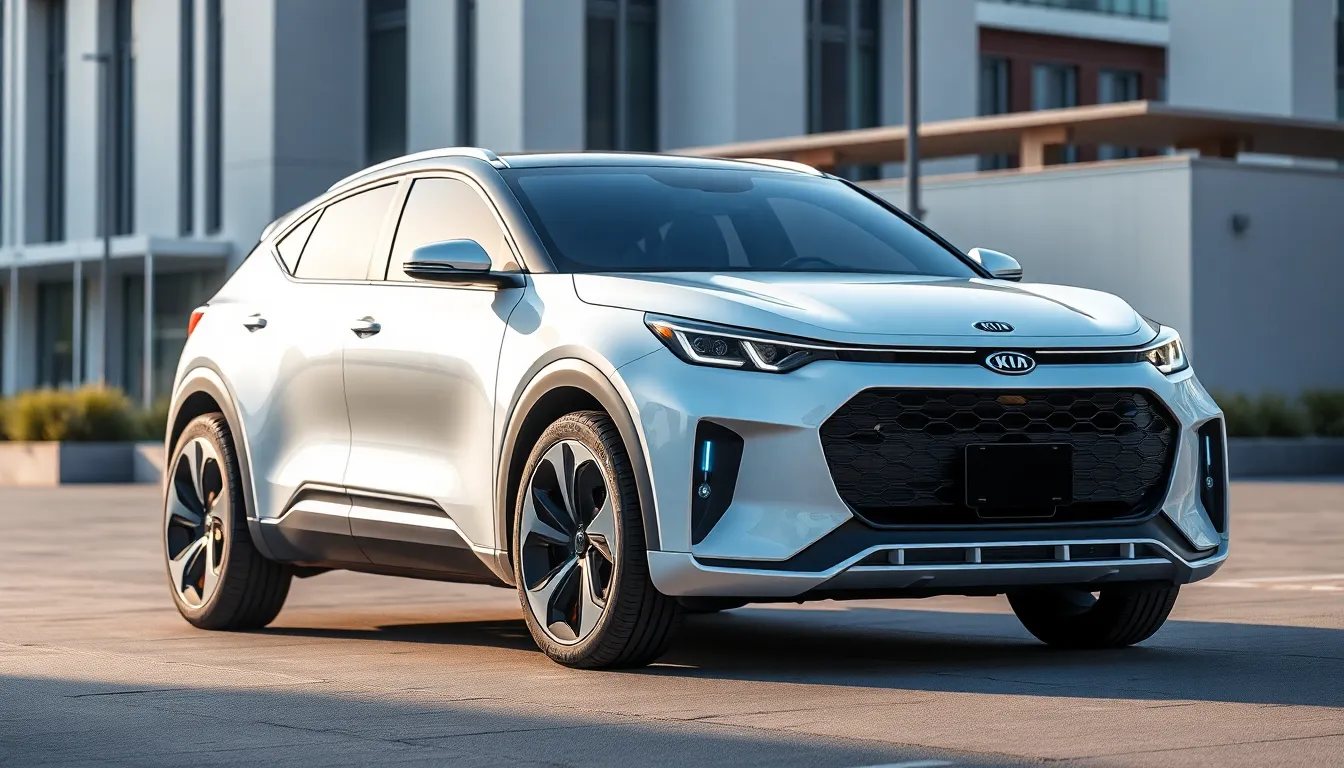
Electric vehicle aesthetics shape Kia’s upcoming design direction as the brand commits to carbon neutrality by 2045. Battery-powered models feature closed-off grilles and aerodynamic body panels that reduce drag coefficients by 12-15% compared to traditional vehicles. EV-exact design elements include illuminated charging ports and unique wheel designs optimized for energy efficiency.
Digital integration expands throughout future Kia interiors with curved OLED displays spanning entire dashboard widths. Touch-sensitive surfaces replace physical controls across climate and infotainment systems, creating seamless cabin experiences. Augmented reality head-up displays project navigation and vehicle data directly onto windshields, eliminating driver distraction from dashboard screens.
Sustainable materials transform interior aesthetics as Kia incorporates recycled ocean plastics and bio-based textiles into premium cabin finishes. Vegan leather alternatives derived from corn and pineapple waste replace traditional animal products without compromising luxury appearance. Natural fiber composites strengthen structural components while reducing overall vehicle weight by 8-10%.
Autonomous vehicle preparations influence exterior proportions with enlarged glass areas and minimized A-pillars for enhanced visibility. Camera systems integrated into body panels eliminate traditional side mirrors, improving aerodynamics and design continuity. Sensor housings blend invisibly into front and rear fascias, maintaining clean aesthetic lines while enabling self-driving capabilities.
Customizable lighting signatures allow owners to personalize vehicle appearance through programmable LED elements across grilles, headlamps, and taillamps. Connected vehicle technology enables remote aesthetic adjustments via smartphone applications, including interior ambient lighting colors and intensity levels. Ever-changing light patterns communicate vehicle status to pedestrians and other drivers during autonomous operation.
Modular design platforms accommodate multiple body styles within shared aesthetic frameworks, reducing development costs while maintaining distinctive model identities. Cross-segment design elements create brand cohesion between compact cars and large SUVs through consistent proportional relationships. Advanced manufacturing techniques enable complex surface geometries that were previously impossible to produce at mass-market price points.
| Future Kia Design Elements | Implementation Timeline | Impact on Aesthetics |
|---|---|---|
| Full-width OLED displays | 2025-2026 | Seamless digital integration |
| Sustainable material adoption | 2024-2027 | Premium eco-conscious finishes |
| Closed EV grilles | 2024-2025 | Enhanced aerodynamic appearance |
| AR windshield projection | 2026-2028 | Minimized interior visual clutter |
| Camera-based mirrors | 2025-2026 | Streamlined exterior profiles |
Conclusion
Kia’s aesthetic journey represents one of the automotive industry’s most impressive transformations. We’ve witnessed a brand evolve from purely functional designs to creating vehicles that genuinely compete with luxury manufacturers on style and sophistication.
The tiger nose grille and bold design language we see today aren’t just cosmetic changes – they reflect Kia’s commitment to proving that affordable doesn’t mean compromising on visual appeal. From the rugged Telluride to the sleek Stinger each model showcases thoughtful design that resonates with modern drivers.
As Kia moves toward an electric future we expect this design evolution to continue pushing boundaries while maintaining the distinctive character that’s made the brand so compelling in recent years.
Frequently Asked Questions
What caused Kia’s dramatic design transformation?
The transformation began in 2006 when Chief Design Officer Peter Schreyer joined Kia, bringing European design philosophy to Korean engineering. This shift moved the brand from utilitarian, affordability-focused vehicles to sophisticated designs that compete with premium automakers, emphasizing both form and function in modern automotive aesthetics.
What is Kia’s signature tiger nose grille design?
Introduced in 2009, the tiger nose grille is Kia’s distinctive front-end design element that adapts across different models. It emphasizes strength in SUVs and elegance in luxury vehicles, featuring variations with LED lighting and active shutters for improved functionality while maintaining brand recognition.
How does Kia’s current design philosophy work?
Kia’s “opposites attract” philosophy combines bold exterior statements with refined interior simplicity. This approach features aggressive design language with sharp character lines and sculptural surfaces outside, while interiors focus on minimalist design, digital integration, and premium materials that rival luxury brands.
Which Kia models best showcase the brand’s aesthetic evolution?
Three standout models exemplify Kia’s transformation: the Sportage combines rugged sophistication with urban refinement, the Telluride offers family-friendly elegance with upscale finishes, and the Stinger delivers performance-inspired beauty with European design elements and driver-focused features.
How do Kia interiors compare to luxury brands?
Modern Kia interiors rival luxury automotive brands through thoughtful material selection, advanced technology integration, and premium finishes. Features include curved display technology, soft-touch materials, ambient lighting systems, and options ranging from synthetic leather to premium Nappa leather.
What design changes can we expect in future Kia electric vehicles?
Future Kia EVs will feature closed-off grilles, aerodynamic body panels, full-width OLED displays, and sustainable materials like recycled ocean plastics. The brand is adapting to autonomous technology with camera-based mirrors and customizable lighting while maintaining its distinctive design identity.
How does Kia’s design compare to competitors like Toyota and Honda?
Kia’s aggressive design language contrasts sharply with the conservative approaches of Toyota and Honda. While Japanese competitors focus on functional aesthetics, Kia offers sculptural body surfaces, premium interiors, and bold styling that matches luxury brand standards at accessible pricing.
What role do colors play in Kia’s aesthetic transformation?
Kia’s distinctive color palette enhances its bold transformation with signature colors like Aurora Black Pearl, Runway Red, Snow White Pearl, Mineral Blue, and Wolf Gray. These colors complement the brand’s sculptural designs and provide visual impact across different trim levels.

